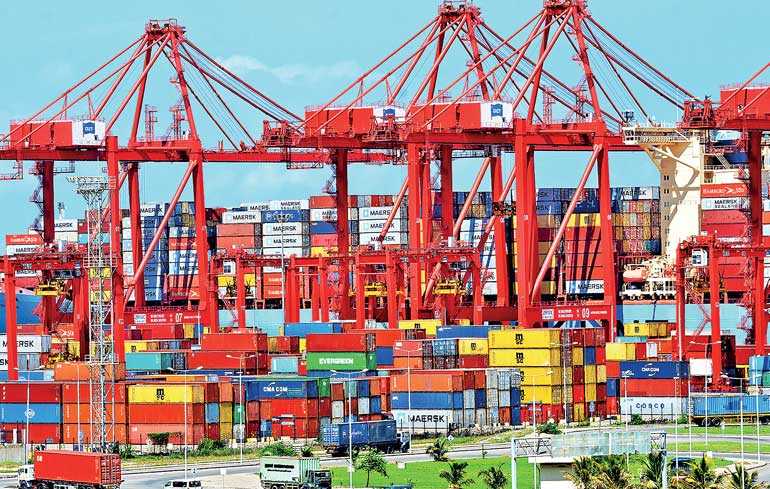Sunday Nov 16, 2025
Sunday Nov 16, 2025
Tuesday, 17 November 2020 00:00 - - {{hitsCtrl.values.hits}}

Exports can be enhanced through a systematic reduction in tariff rates on a selective range of intermediate inputs to increase export value
By Dr. Kingsley Bernard
 Since the outbreak of the coronavirus epidemic, most of the countries and their governments have now realised that the best strategy to come to terms with the epidemic is to live with it and take all the precautions to reduce the spread of the microscopic organ COVID-19.
Since the outbreak of the coronavirus epidemic, most of the countries and their governments have now realised that the best strategy to come to terms with the epidemic is to live with it and take all the precautions to reduce the spread of the microscopic organ COVID-19.
For almost one year since the outbreak of the epidemic in China for the first time, it has impacted all facets of our lives, governments, and countries. In most of the areas of activity, its impact has been detrimental and economies of countries irrespective of their status are the most affected. In this context, most of the countries are turning to their export sectors for mitigating the negative effect of COVID-19 on their economies, by enhancing exports.
There are several alternative strategies to boost exports of any country. To enhance exports there are short-term, medium-term, and long-term strategies. However, in the context of a sudden outbreak of an epidemic, governments must immediately resort to short-term strategies that will have an immediate impact to mitigate the negative effect on the economies.
More commonly used short-term strategies that would bring in immediate results are a) devaluation of currency b) giving direct loans to expand existing businesses and or to set up new businesses. These two strategies may not yield expected results as the devaluation will result in negative economic effects on a predominantly import-oriented country. Further, the second strategy may not bring in expected results as it may not stimulate businessmen to take loans and invest more in business if the related costs are high. Therefore, this article suggests a more direct strategy for enhancing exports through a systematic reduction in tariff rates on a selective range of intermediate inputs to increase export value.
Tariff reduction
According to research studies conducted in many countries using tariff rates as an instrument of trade policy has been successful. It was evident that export performance indicators have improved with the reduction of input prices. Therefore, reducing the tariffs on low-priced high-quality intermediate inputs on a selective range of inputs can be made available to the local manufacturer that will lead to better quality exports of the final product.
This article proposes a relatively new methodology based on a systematic approach to tariff reduction on intermediate inputs based upon its importance ranging from high to low, finally to facilitate high value-added exports where the technology is constrained and the economy relies greatly on imported goods
Emerging literature emphasises the effectiveness of intermediate input tariff reductions in enhancing exports. Studies conducted in developing countries on both input and output tariff have concluded that firms have achieved substantial productivity gains from input tariff reductions. Further, these gains have outweighed the benefits of output tariff reductions. According to research findings, a reduction in import tariffs is important to developing countries that face technological constraints because of shortages of imported inputs. The countries those who have come out of the import substitution phase are more likely to face this situation.
Positive and negative effects
Tariff reduction on intermediate goods is likely to have both positive as well as negative effects on the economy.
Firstly, it can provide low-priced high-quality intermediate inputs to the manufactures of finished goods which facilitate these manufacturers to increase their production and help the economy to grow. On the other hand, it can pose challenges to existing local manufacturers of intermediate goods by creating a more competitive market. Therefore, it is necessary to adopt a conservative approach and an appropriate methodology to select a list of intermediate inputs based on priority, ranging from extremely important to insignificantly important.
This analysis can be further extended to identify input categories so that tariff rates can be managed to have a positive impact on the economy by protecting the local manufacturer of high-quality intermediate inputs and offset any declines in fiscal revenues due to earlier proposed tariff reductions.
Using this methodology, a list of intermediate inputs that have a strong correlation between intermediate tariff rates and export value of the final product at the sector level of two-digit HS code can be created (HS is a digital coding system used globally for classifying goods traded by more than 200 countries for collection of international trade statistics and as a basis for customs tariffs developed by the World Customs Organization (WCO).
The details of the good increases as the number of digits of the code goes up, generally, for trading purposes, a six-digit HS Code is used). This input list can be further extended for identifying a list of inputs for tariff reduction at HS-6digit code, which have a high import unit value compared to the average unit value available to the local exporter.
Hence this is a method of recommending tariff reduction strategically for intermediate inputs sequentially from extremely important to insignificantly important intermediate inputs depending on the quality of such inputs locally available.
This analysis must be extended to select the categories of inputs where the tariff rates can be maintained based on a scale of importance. To do this, locally produced high-quality intermediate inputs that may require protection are listed based upon their average unit value available to the local manufacturer, which are higher than the import unit value, significantly. Hence, the Government can increase the tariff rates up or at least maintain the old tariff rate for these selected input categories to reduce the negative effect on revenues to the Government due to the tariff reductions proposed on other input categories.
Good fit for Sri Lanka
Sri Lanka’s economy fits well satisfying the two requirements listed above, namely technological constraints and policy shifts, for tariff reductions. During the ’50s and ’70s, the country experienced an import substitution phase mainly to encourage the local firms and enhance the industrial base.
During the latter part of the ’70s, the policy shifted towards the export promotion schemes with the introduction of open economic policies and Sri Lanka joining the World Trade Organization (WTO) in 1995. It is proposed that for Sri Lanka to increase its exports, and to compete with neighbours in the region, it should focus on negotiating with other countries on a similar kind of an input list. Therefore, this article argues that given the technological constraints and policy shifts, to boost exports and improve export unit value, a more strategic approach needs to be devised by Sri Lanka.
Apparel sector
The implementation of this method is a tedious exercise, though it is not difficult to explain. For example, if we take the apparel sector based upon its relevance for Sri Lanka, the procedure for this analysis can be briefly explained as follows.
It is necessary to identify the intermediate inputs used by the apparel sector in Sri Lanka, for this data from the Department of Customs and Census and Statistics (e.g. 2017) can be used. Then out of those intermediate inputs, we list one of our competitor country’s (India, Pakistan, or any other country) top eight imported intermediate inputs, for example, based on their high correlations between intermediate inputs and the export value in the selected country.
Firstly, for this exercise the inputs data will be coded based on HS 2digit codes to identify the categories of inputs. Consequently, this list must be extended to HS-6digit code to identify detailed input categories within each HS-2digit category. Then to identify the tariff rates for all these HS-6digit categories for Sri Lanka, Bangladesh, and Vietnam (or any other countries) for a recent year (e.g. 2018) data from Tariff Analysis Online by the World Trade Organization (WTO) can be made use of.
Next, we create a unique ID, identifying each country, sector, input and year, using it to merge the inputs with their respective tariff rates and import values for all the three countries for that respective year. The next step is to calculate the export unit value and the import unit value for all the HS-6digit categories based upon their HS codes using the UN Com trade database.
Then using this data, we can calculate the average unit value at HS-6digit code. The average unit value is used as a close proxy for the quality of the intermediate inputs available in the local market. Next, the average unit value is compared to the import unit value to identify the Tariff Reduction Zones (TRZs). Finally, we use this information to generate a list of HS-8digit codes to identify the name of the specific intermediate inputs that fall within each respective TRZ.
This is a brief explanation using an example of how to apply the above-mentioned methodology in practice. It should be noted that this is a serious and meticulous exercise to select the appropriate intermediate input items for tariff reduction. In the context of the present Government’s efforts in rationalising imports to Sri Lanka, this kind of study would shed a lot of light on understanding the correct situation and improving exports from Sri Lanka at this crucial juncture.
[Dr. Kingsley Bernard is highly recognised for his significant contribution to the development of the export sector of Sri Lanka. He has held the positions of Director – Marketing of the Export Development Board (EDB), Management Consultant of Sri Lanka Export Credit Insurance Corporation (SLECIC), Vice President of the Exporters Association of Sri Lanka (EASL) of the Ceylon Chamber of Commerce and President of the National Chamber of Exporters of Sri Lanka (NCE) during a vibrant era for the export sector in Sri Lanka (Decade of Exports 1990-2000 and beyond). He was also the CEO of Dankotuwa Porcelain PLC; the company was adjudged the ‘Most Outstanding Exporter of the Year’ for three consecutive years at the NCE Export Awards Ceremony during his tenure of office as the CEO. He was also the Chairman of the Joint Business Forum of Trade Chambers of Sri Lanka (JBiz) and Ceramics Manufacturers and Exporters Association of Sri Lanka. Dr. Bernard is a highly qualified academic and a top professional who has a proven track record.]